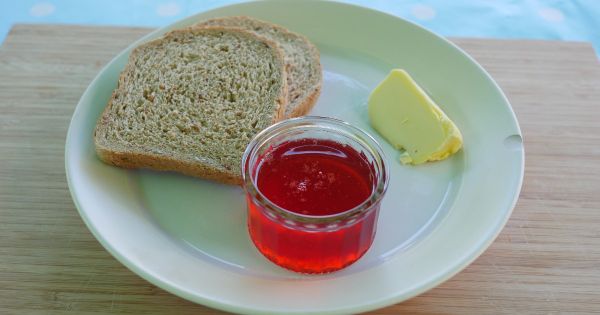How To Make Jam In A Bread Maker


Introduction
The easy way for a gardener to organise their growing and discover gardening ideas.
Step By Step Video
YouTube Video
Hello Two!
Hello Three!
Using a bread maker to make jam is easier and quicker than other methods. Alternatively, you may like to see my full guide on how to make jam (this includes the principles of jam making and a selection of jam recipes), or the entire collection of fruit recipes.
About Making Jam
Preserving fruit in jam is a centuries old pastime. What is less known nowadays is that preserving fruit as jam retains a surprisingly large proportion of vitamin C and other goodies. In days before a freezer, it was an excellent way of ensuring that the goodness of summer fruit was available all year round.
Jam is typically 50% sugar and 50% fruit. Recipes may have slightly higher sugar for tart fruit like gooseberries, or less for particularly sweet strawberries. The high sugar content is essential for both preservation and setting.

Step By Step – Making Jam In A Bread Maker
Not all bread makers have a programme or setting for making jam. The picture below shows the setting on my bread maker.

Having this setting on a bread maker provides a very convenient way of making jam, with only a few more steps compared to making bread.
Bread Maker Jam Recipe
- 700 g of fruit
- 600 - 700 g of caster sugar
- Depending on the fruit – up to 13 g of pectin
This should make enough jam for 3 standard size jam jars.
*Some bread makers come with a recipe booklet for making bread, jams, and cakes.
About Pectin In Jam Making
Pectin helps jam set. Some fruit naturally contain high levels of pectin. These include:
- Gooseberries
- Blackcurrants
- Redcurrants
- White currants
- Blueberries
Other fruit are low in pectin, such as:
- Strawberries
- Raspberries
- Tayberries
To be safe, add 3 g of pectin per recipe even for fruit high in pectin. For fruit low in pectin, add up to 13 g. This can be done in two ways:
- By using jam sugar
(sugar already prepared with pectin)(available in nearly all major supermarkets) - Buying pectin sachets
In my experience, the cheapest approach is to buy pectin sachets and add this to the sugar.
Step 1 – Preparing The Fruit
The fruit needs to be clean. My method is to soak the fruit for about 10 minutes in cold water and then rinse thoroughly.

Some soft fruit like strawberries and raspberries can simply be chopped up thickly before cooking. The cooking process will naturally break up the chunks. Other fruit like gooseberries may need to be topped and tailed, or even smashed into a pulp, before cooking.

Some homegrown fruit like redcurrants or white currants can be full of seed, that many people choose to remove before making jam. There are a few ways of removing seed. One easy option is to use a juicer to extract the juice. Alternatively, blanch the fruit for a minute or two in boiling water, remove the water, and then smash up the fruit. The mixture can then be sieved (or even better strained through muslin).
Step 2 – Cooking The Jam

If using a bread maker the process could hardly be simpler. Place all the ingredients in the bread baking tin, choose the correct settings, and that is it! About 100 minutes later your jam will be ready.
Step 3 – Sterilisation
The cooked jam will need to be placed in clean sterilised jars (and lids). I find the easiest way of doing this to be:
- Placing washed and rinsed jars in a preheated oven of 100 - 120 °C for 20-30 minutes
- Putting the lids in boiling water for 5 - 10 minutes

Ideally the jars and lids will be ready (i.e. still hot) at the same time as the jam. Be careful not to burn yourself!
Step 4 – Decanting The Jam Mixture
A bread maker helps control the jam making process, ensuring the fruit is cooked in the optimum conditions to help ensure a good ‘set’.

When the jam has finished cooking it should be decanted as quickly as possible into the sterilised jars and sealed with their lids. A ladle or large spoon will work, but a specialist jam funnel makes the process much less messy.
Ensure that the threads and jam tops are completely jam free, if necessary by wiping with clean kitchen paper, before tightly screwing on the lids.
You should hear the lids ‘pop’ after 10-20 minutes indicating an air tight seal as the mixture cools (this is the depression you see in jam jars lids). You may like to see this YouTube video on sealing jam jars, that includes an additional step of boiling the filled jam jars to secure a strong seal.
Variations in sugar and pectin levels in fruit means that jam making is not an exact science, and even properly made jam will be runny when hot. The jam will thicken naturally as it cools down,
You may still want to test the cooked jam thickness by decanting a small portion of the boiling fruit mixture onto a prepared cold plate (i.e. one placed in a freezer drawer). After 30 seconds, if the mixture has kept its shape and is not runny, and wrinkles when touched, the jam is ready. Otherwise, continue cooking the mixture for another few minutes in the bread maker and try again.
When cool, store your homemade jam in the fridge. It should last for many months. Good luck!
See all the fruit recipes.
